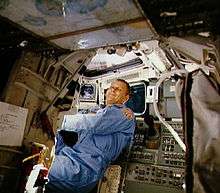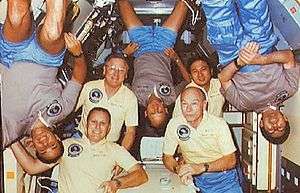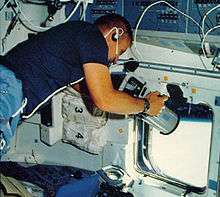Robert F. Overmyer
Robert Franklyn "Bob" Overmyer (July 14, 1936 – March 22, 1996) (Col, USMC) was an American test pilot, naval aviator, aeronautical engineer, physicist, United States Marine Corps officer and USAF/NASA astronaut. Overmyer was selected by the Air Force as an astronaut for its Manned Orbiting Laboratory in 1966. Upon cancellation of this program in 1969, he became a NASA astronaut and served support crew duties for the Apollo program, Skylab program and Apollo-Soyuz Test Project. In 1976, he was assigned to the Space Shuttle program and flew as pilot on STS-5 in 1982 and as commander on STS-51-B in 1985. He was selected as a lead investigator into the Space Shuttle Challenger disaster and retired from NASA in 1986. Ten years later, Overmyer died in Duluth, Minnesota while testing the Cirrus VK-30 composite homebuilt aircraft.
Robert F. Overmyer | |
|---|---|
 | |
| Born | July 14, 1936 Lorain, Ohio, U.S. |
| Died | March 22, 1996 (aged 59) |
| Resting place | Arlington National Cemetery |
| Nationality | American |
| Other names | Robert Franklyn Overmyer |
| Alma mater | BW, B.S. 1958 NPS, M.S. 1964 |
| Occupation | Naval aviator, test pilot |
| Awards | |
| Space career | |
| USAF / NASA Astronaut | |
| Rank | |
Time in space | 12d 02h 22m |
| Selection | 1966 USAF MOL Group 2 1969 NASA Group 7 |
| Missions | STS-5, STS-51-B |
Mission insignia | |
| Retirement | June 1986 |
Early life and education
Overmyer was born on July 14, 1936, to Rolandus Overmyer (1906–1967) and Margaret June Overmyer (née Fabian; 1909–1979) in Lorain, Ohio, but considered Westlake, Ohio his hometown. Overmyer was active in the Boy Scouts of America and earned the rank of First Class.[1] He graduated from Westlake High School in 1954 and earned a Bachelor of Science degree in physics from Baldwin Wallace College in 1958 and a Master of Science degree in aeronautics with a major in aeronautical engineering from the U.S. Naval Postgraduate School in 1964.[2]
Career
Marine Corps
Overmyer entered active duty with the Marine Corps in January 1958. After completing Navy flight training in Kingsville, Texas, he was assigned to VMA-214 in November 1959. He was assigned to the U.S. Naval Postgraduate School in 1962 to study aeronautical engineering. Upon completion of his graduate studies, he served one year with Marine Maintenance Squadron 17 at MCAS Iwakuni, Japan before being assigned to the U.S. Air Force Test Pilot School at Edwards Air Force Base, California. He was chosen as an astronaut for the Manned Orbiting Laboratory (MOL) program in 1966.[2]
Overmyer logged over 7,500 flight hours, with over 6,000 in jet aircraft.[2]
NASA
The MOL program was canceled in 1969 and Overmyer was selected as part of NASA Astronaut Group 7, where his first assignment was engineering development on the Skylab Program from 1969–71. From 1971–72, he was a support crew member for Apollo 17 and was the launch capsule communicator (CAPCOM). From 1973–75, he was a support crew member for the Apollo-Soyuz Test Project and was the NASA CAPCOM in the mission control center in Moscow. In 1976, he was assigned duties on the space shuttle Approach and Landing Tests (ALT) program and was the prime T-38 Talon chase pilot for Orbiter Free-Flights 1 and 3. In 1979, he was assigned as the deputy vehicle manager of OV-102 (Columbia) in charge of finishing the manufacturing and tiling of Columbia at the Kennedy Space Center in preparation for its first flight. This assignment lasted until Columbia was transported to the launch pad in 1980.[2]
Space Shuttle
STS-5

Overmyer was the pilot for STS-5, the first fully operational flight of the shuttle program, which launched from Kennedy Space Center, Florida, on November 11, 1982. He was accompanied by spacecraft commander Vance D. Brand and two mission specialists, Joseph P. Allen and William B. Lenoir. STS-5, the first mission with a four-man crew, clearly demonstrated the shuttle as fully operational by the successful first deployment of two commercial communications satellites from the orbiter's payload bay. The mission marked the first use of the Payload Assist Module (PAM-D) and its new ejection system. Numerous flight tests were performed throughout the mission to document shuttle performance during launch, boost, orbit, atmospheric entry and landing phases. STS-5 was the last flight to carry the Development Flight Instrumentation (DFI) package to support flight testing. A Getaway Special, three Student Involvement Projects and medical experiments were also included on the mission. The STS-5 crew successfully concluded the five-day orbital flight of Columbia with the first entry and landing through a cloud deck to a hard-surface runway and demonstrated maximum braking. Mission duration was 122 hours before landing on a concrete runway at Edwards Air Force Base, California, on November 16, 1982.[2]
STS-51-B

Overmyer was the commander of STS-51-B, the Spacelab-3 (SL-3) mission. He commanded a crew of four astronauts and two payload specialists conducting a broad range of scientific experiments from space physics to the suitability of animal holding facilities. STS-51-B was also the first shuttle flight to launch a small payload from a "Getaway Special" canister. STS-51-B launched at 12:02 p.m. EDT on April 29, 1985 from Kennedy Space Center, Florida, and landed at Edwards Air Force Base, California, at 9:11 a.m. PDT on May 6, 1985. STS-51-B completed 110 orbits of Earth at an altitude of 190 nautical miles.[2]

In 1986, Overmyer was one of NASA's lead investigators into the Challenger disaster.
Overmyer retired from NASA and the Marine Corps in May 1986.[2]
Post NASA
After retiring from the space industry, Overmyer commenced his own consulting business, Mach Twenty Five International, Inc. He consulted with major aerospace corporations and the National Broadcasting Corporation (NBC) as well as writing a column for the British magazine Space Flight News. In March 1988, he joined the Space Station Team at McDonnell Douglas Aerospace, where he led crew and operations activities for seven years. He retired from McDonnell Douglas in April 1995 and expanded the scope of Mach Twenty Five International, continuing his aerospace consultation work as well as speaking engagements and writing.[3]
Test pilot
Overmyer continued his career as a general aviation test pilot. Having former experience with aeronautical testing at both U.S. Air Force Test Pilot School and NASA, he joined Minnesota-based aircraft manufacturer Cirrus Design (now called Cirrus Aircraft) as a test pilot in November 1995. He contributed to stall testing of the company's first design, the Cirrus VK-30 kit aircraft, which first flew in 1988. He also performed early certification testing for the Cirrus SR20, which was certified in 1998 and helped pioneer the use of glass cockpits, composite materials and ballistic parachutes in the light production aircraft industry.[4]
Death
Overmyer died in a plane crash on March 22, 1996 near the Duluth International Airport while testing the Cirrus VK-30.[4] He was testing the plane's wing for full-flap stall recovery characteristics at aft center of gravity limits. He was interred in Arlington National Cemetery.[5] He is survived by his wife, Katherine, and children Carolyn Marie (born 1966), Patricia Ann (born 1968) and Robert Rolandus (born 1970).[2]
Organizations
Overmyer was a member of the Society of Experimental Test Pilots, Experimental Aircraft Association and Aircraft Owners and Pilots Association.[2]
Awards and honors
Overmyer was awarded the Air Force Meritorious Service Medal in 1969 for duties with the USAF Manned Orbiting Laboratory program; the Marine Corps Meritorious Service Medal in 1978 for duties as the chief chase pilot and support crewman for the Shuttle Approach and Landing Test Program; an Honorary Doctor of Philosophy degree from Baldwin Wallace College, December 1982; the U.S. Naval Postgraduate School Distinguished Engineers Award in January 1983; the Distinguished Flying Cross (1983); and the NASA Space Flight Medal (1983).[2]
See also
References
![]()
- Robert F. Overmyer at scouting.org Archived 2016-03-04 at the Wayback Machine
- National Aeronautics and Space Administration (March 1996). "Astronaut Bio: Robert Overmyer 3/96". NASA. Retrieved April 17, 2012.
- "Robert Overmyer's post-NASA career". arlingtoncemetery.net. May 2006. Retrieved December 20, 2018.
- Warwick, Graham (April 1996). "Former astronaut killed in Cirrus VK30 test crash". Retrieved 2016-01-29.
- "Robert Franklin Overmyer, Colonel, United States Marine Corps & American Astronaut". Michael Robert Patterson. May 15, 2006. Retrieved April 17, 2012.
External links
| Wikimedia Commons has media related to Robert F. Overmyer. |